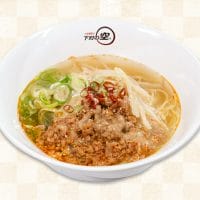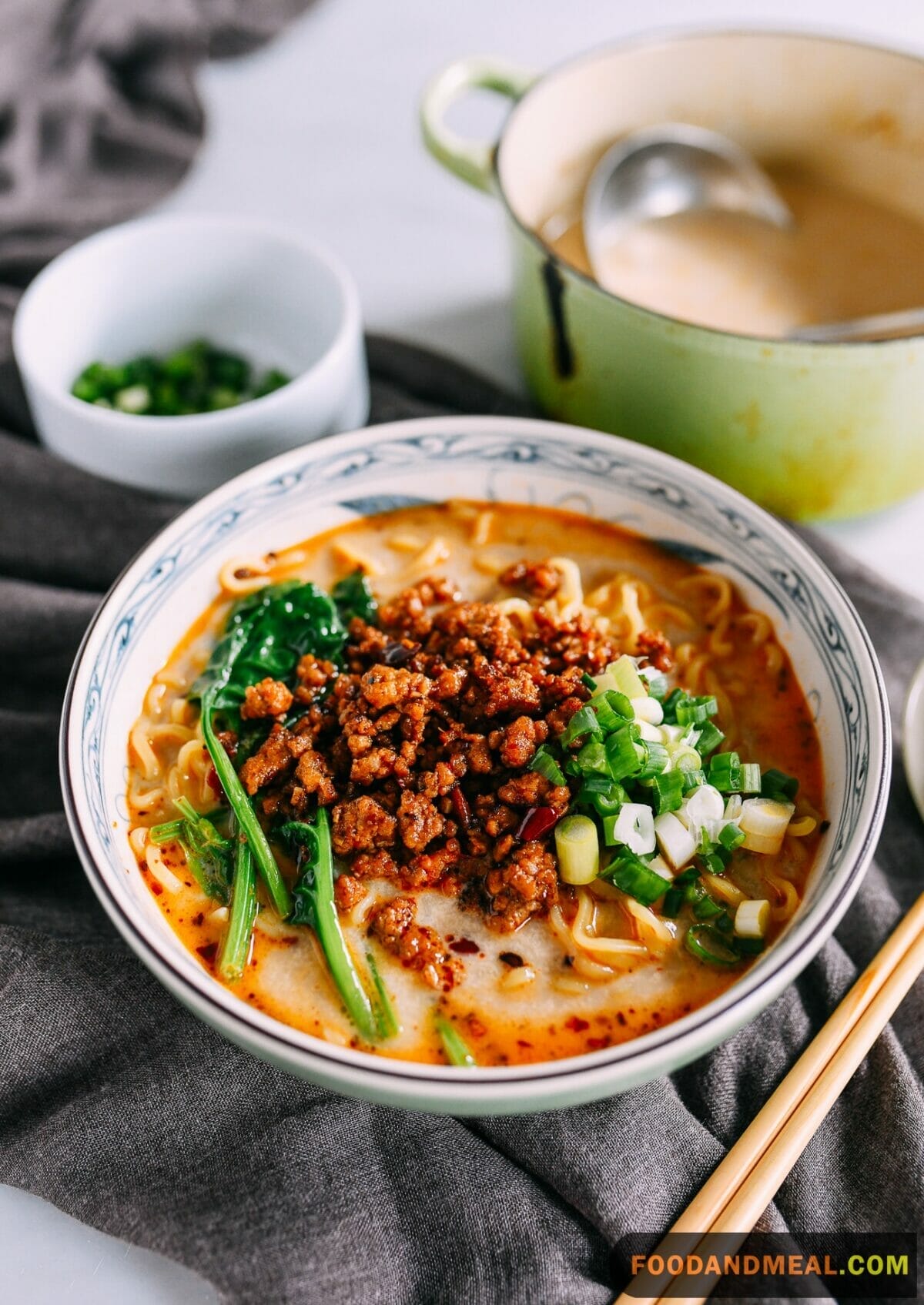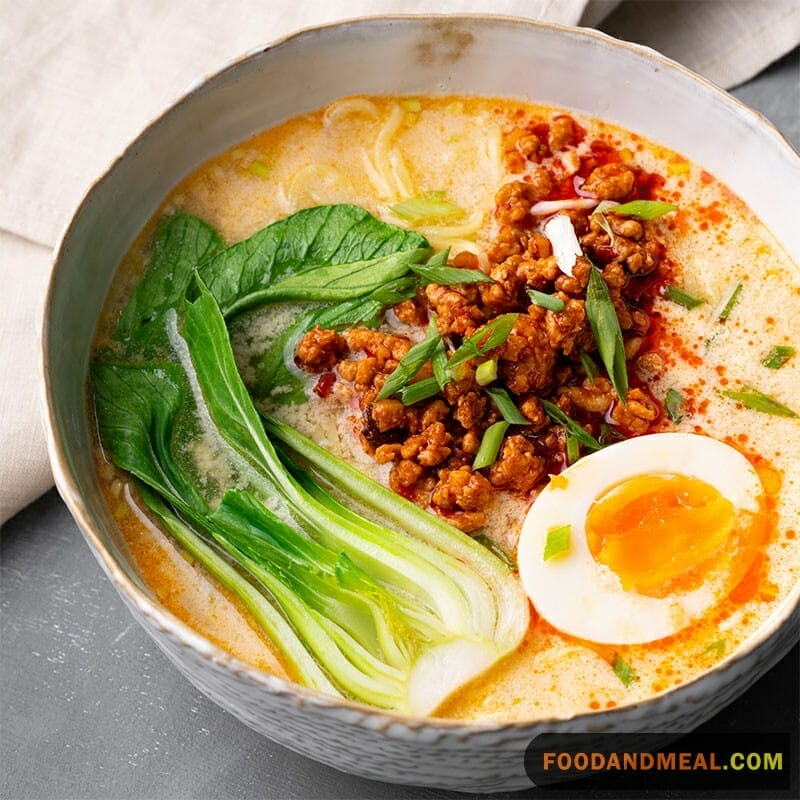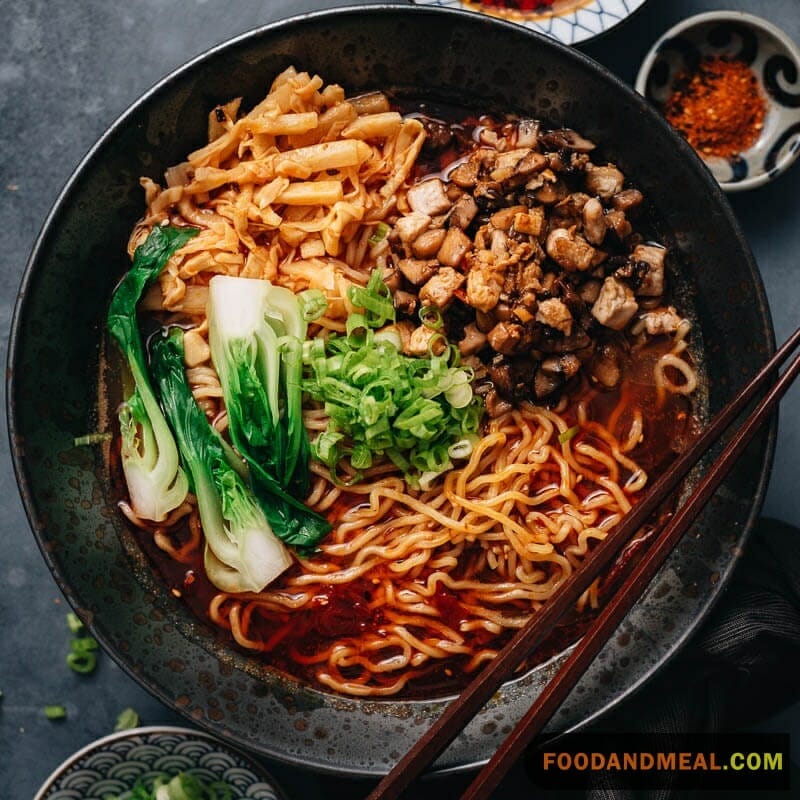If you’re looking for a quick and easy bowl of Japanese ramen, try the Shio Tantanmen at Food And Meal. The veteran instant noodle maker is now bringing this classic Japanese dish to the West. Whether you prefer the brothy version, or the spicy one, you’ll be pleased with these variations. These are the easiest ways to make tantanmen in under 10 minutes.
Shio Tantanmen Recipes


Shio Tantanmen
Equipment
Ingredients
- ½ cup Shio Tare
- ¼ cup Chile Oil
- ¼ cup Sesame Paste
- 5 cups any type clear soup
- 1⅓ pounds noodles fresh, such as Chukasuimen
- 1⅓ cups Niku Soboro
- Green Vegetable Topping
Instructions
- With all your ingredients ready to go, bring a large pot of water to a boil over medium-high heat.
- Heat your ramen bowls by filling them halfway with hot water. The bowls don’t need to be scalding, but they should be hot to the touch. Dump out the hot water and dry the bowls with some paper towels or a clean towel.
- Put the tare, chile oil, sesame paste, and soup in a medium saucepan. Mix and bring to a simmer over low heat.
- Cook the noodles in the large pot of boiling water. Ramen that has been cut to a standard thickness (about 1 mm) will cook in 1 to 2 minutes.
- About 30 seconds before the noodles are finished cooking, ladle the soup into the ramen bowls.
- Drain the noodles, taking care to shake off as much excess water as you can. Carefully place some noodles in each bowl of soup, keeping them tidy.
- Place the niku soboro and green-vegetable topping neatly on the
- ramen. Serve immediately.
Video
Notes
- If you can find Szechuan peppercorns, they add a nice touch to this dish. It is a very bitter spice, but authentic tantanmen always has a bit of it. Just crush it gently with the flat side of a knife and sprinkle just a little bit over your ramen.
- Soup: Mix equal parts unseasoned low-sodium chicken broth and dashi broth. Japanese dashi powder to make broth can be found in the Asian foods section of many supermarkets or in Asian grocery stores or online.
- Noodles: Use 3 ounces of dried ramen noodles per bowl, preferably the thin, straight style.
- Toppings: Chile oil
Nutrition
© Food And Meal
This website provides approximate nutrition information for convenience and as a courtesy only. Nutrition data is gathered primarily from the Spoonacular Database, whenever available, or otherwise other online calculators.
Alternative Preparation Method: Slow Cooker Shio Tantanmen

Ingredients:
- 1 pound (450g) pork belly, thinly sliced
- 1 medium onion, thinly sliced
- 4 cloves garlic, minced
- 2 tablespoons sesame oil
- 1 tablespoon vegetable oil
- 2 tablespoons chili bean paste (Toban Djan)
- 2 tablespoons miso paste
- 2 tablespoons soy sauce
- 1 tablespoon sesame paste
- 1 tablespoon sugar
- 8 cups (1.9 liters) chicken broth
- 8 ounces (225g) ramen noodles
- 4 soft-boiled eggs, halved
- 4 green onions, finely chopped
- 1 sheet nori (seaweed), cut into small pieces
- Chili oil, for garnish (optional)
Instructions:
- Sear the Pork: In a skillet over medium-high heat, add the vegetable oil and sear the pork belly slices until they’re browned on both sides. Remove the pork and set it aside.
- Slow Cooker Setup: Transfer the seared pork belly to a slow cooker. Add the sliced onion, minced garlic, and sesame oil.
- Prepare the Broth: In a separate bowl, whisk together the chili bean paste (Toban Djan), miso paste, soy sauce, sesame paste, and sugar. Pour this mixture over the pork and onions in the slow cooker.
- Add Broth: Pour the chicken broth into the slow cooker, ensuring that the pork and onions are fully submerged.
- Slow Cook: Cover the slow cooker and cook on low for 6-8 hours or until the pork is tender and can be easily shredded with a fork.
- Boil Ramen Noodles: About 30 minutes before serving, boil the ramen noodles according to the package instructions. Drain and set aside.
- Shred the Pork: Once the pork is tender, remove it from the slow cooker and shred it into smaller pieces using two forks.
- Assemble the Bowls: To serve, divide the cooked ramen noodles among four bowls. Ladle the flavorful broth over the noodles.
- Add Toppings: Top each bowl with the shredded pork, soft-boiled egg halves, chopped green onions, and nori pieces. If you enjoy extra heat, drizzle a bit of chili oil on top.
- Serve Hot: Serve your Slow Cooker Shio Tantanmen piping hot and enjoy the rich, spicy flavors.
Tips for making Shio Tantanmen

Cooking Tips
- Don’t Overcook the Pork: Achieving tender pork slices is crucial. Don’t overcook them during the initial searing or in the slow cooker. The meat should be soft and melt in your mouth.
- Balance the Seasonings: Adjust the amount of chili bean paste (Toban Djan) and sesame paste according to your spice tolerance. Start with the recommended measurements and add more gradually if you like it spicier or creamier.
- Slow Cooker Timing: Be patient with your slow cooker. Allow the flavors to meld together by cooking on low for the recommended 6-8 hours. Rushing this step can result in less flavorful broth.
- Soft-Boiled Eggs: Achieving the perfect soft-boiled egg requires precision. Boil for 7 minutes, then immediately transfer to an ice bath to stop the cooking process. This ensures a runny yolk.
- Cook the Noodles Al Dente: Overcooking ramen noodles can make them mushy. Boil them separately and cook just until they reach the al dente stage. Rinse with cold water to stop the cooking process.
Serving Suggestions

- Complement with Pickled Vegetables: Serve pickled vegetables like cucumbers, bean sprouts, or kimchi on the side. Their crisp, tangy flavors complement the rich broth.
- Add a Kick of Spice: For spice lovers, offer chili oil or shichimi togarashi (Japanese seven-spice blend) as condiments. Let diners customize their spice level.
- Serve with Gyoza: Gyoza (pan-fried dumplings) make an excellent side dish. Their crispy texture and savory filling balance the meal.
- Freshen Up with a Salad: A simple side salad with sesame dressing or a light citrus vinaigrette adds freshness to the meal.
- Pair with Japanese Green Tea: A cup of Japanese green tea, such as sencha or genmaicha, complements the flavors and aids digestion.
- Ramen Burger: Get creative by turning your Shio Tantanmen into a ramen burger. Use ramen noodle buns for a fun twist.
- Vegetarian Options: Offer a vegetarian version of the dish with tofu or mushrooms instead of pork for those with dietary preferences.
- Don’t Forget the Corn: Corn kernels are a classic ramen topping. They add a touch of sweetness and a pleasant contrast in texture.
- Ramen Eggs: Marinated ramen eggs (ajitsuke tamago) make a delightful side dish or garnish. Their soy-infused flavor complements the broth.
- Play with Toppings: Encourage diners to get creative with toppings like bamboo shoots, narutomaki (fish cake), and toasted sesame seeds.
Frequently Asked Questions about Shio Tantanmen

- Can I make this dish vegetarian? Absolutely! Substitute the pork with tofu, mushrooms, or your favorite plant-based protein. Use vegetable broth, and you have a delicious vegetarian Shio Tantanmen.
- How can I store leftovers? To store leftovers, separate the broth, noodles, and toppings. Keep them in airtight containers. The broth can be refrigerated for up to 3 days, while the noodles and toppings are best fresh. Reheat the broth and assemble when ready to enjoy.
- Can I make the broth in advance? Yes, you can prepare the broth ahead of time and store it in the refrigerator for a day or two. This can save you time when serving.
- What if I can’t find ramen noodles? If you can’t find authentic ramen noodles, substitute with udon or soba noodles. While the texture will differ slightly, it will still be delicious.
- How can I make the dish spicier? To make your Shio Tantanmen spicier, simply increase the amount of chili bean paste (Toban Djan) or add chili oil to your bowl to adjust the heat level to your liking.
Enjoy restaurant-quality Shio Tantanmen at home with our easy recipe. Discover expert tips and FAQs. Try it today!
I'm James F Anderson, a noted sous chef from London and a Le Cordon Bleu alumnus. My career began in a Michelin-starred Parisian eatery, where my blend of classic and contemporary cooking, using seasonal ingredients, earned accolades. Recognized in culinary publications and on cooking shows, I’m committed to mentoring aspiring chefs and delivering memorable dining experiences, marking me as a standout talent in the culinary world.



